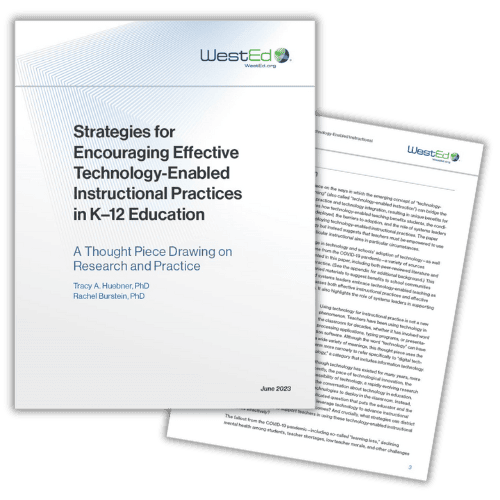
Elevating Technology-Enabled Instruction
06/21/2023

Bridging Instructional Practice and Technology Integration
Dr. Huebner is the Director of Advancement Teaching and Learning at WestEd. Dr. Burstein is an independent education researcher and writer. Huebner and Burstein collaborated on the thought piece that forms the basis for this post. WestEd originally published this blog.
By any measure, schools across the United States are awash in edtech resources. School systems collectively spend tens of billions of dollars per year on technology—a figure that skyrocketed during remote learning with the infusion of federal funding during the COVID-19 pandemic. The number of digital tools used by educators has also soared, with one report finding districts used around 1,500 different digital tools per month during the 2020/21 school year, on average.
At the same time, the assumption that technology and spending would coincide with—let alone produce—better learning outcomes, especially among students from historically underserved communities, doesn’t appear to be true. The opposite is occurring, with significant declines in math and reading scores during this period of increased access to technology.
What accounts for this discrepancy? Many experts suggest the answer is the role of instructional practice with technology integration. To put it simply, systems and leaders should support teachers in unlocking the potential of a well-designed digital tool by engaging in instructional practices that reveal a core set of benefits. In this blog post, we explore the idea of technology-enabled instruction and what it looks like in practice.
Unlocking the Benefits of Technology for Meeting Instructional Goals
What does this look like in practice? We examine this idea in a newly published paper.
Consider the below scenario of a social studies teacher who aims to fulfill a learning objective related to understanding international trade of goods and services.
As part of this scenario, the teacher might use an instructional framework to identify the pedagogies that are most effective for promoting student learning about international trade. The teacher might employ scaffolding—first defining goods and services, then asking students to classify goods and services, next asking students to develop examples, and finally exploring concepts related to trade and discussing applications in the current economy. The unit might culminate in a class debate about the benefits and drawbacks of international trade for different groups.
Simultaneously, in this scenario, the teacher might use a technology integration framework to structure and organize class use of technology. Perhaps the teacher decides to use a digital whiteboard listing the results of the class brainstorm of goods and services as the basis for small group discussions of trade. Students may use the digital whiteboard to develop ideas for class debates about international trade. In this case, the teacher is pushing the potential of the digital whiteboard as a helpful tool in instruction.
However, missing from both these scenarios is an opportunity to unify instructional practice with technology integration, using technology to unlock instructional opportunities that wouldn’t otherwise be possible.
What might that unification look like for the social studies teacher exploring goods and services and international trade? The teacher might organize a virtual field trip or conduct video interviews with economists and other experts.
Defining Technology-Enabled Instruction
Such use of technology to improve instruction and learning outcomes is “technology-enabled instruction.” This emerging term aims to get beyond whether and which technologies are accessible and used in the classroom, to how teaching with technology can advance student learning. As the educational researchers Peggy A. Ertmer and Anne Ottenbreit-Leftwich explained in a 2013 article, the term seeks to “shift … focus from technology integration (and the tools used to achieve it) to technology-enabled learning (and the pedagogy used to support it).”
In order to make this shift, the field needs to support teachers by ensuring that they have the materials and resources necessary to carry out technology-enabled instruction. That support begins with an understanding of the gap in the framework’s ecosystem that technology-enabled instruction aims to fill.
There is a gap between instructional practice and technology integration. Learning why the gap exists and how to address it will help practitioners to be more intentional about using technology to elevate their instruction. Working with school and district leaders to understand how technology can elevate instruction will help to bridge the gap. Working with designers to bridge the two concepts together will help to advance the field.
 Read more about the research and best practices
Read more about the research and best practices
Learn more about the research on tech-enabled practice inStrategies for Encouraging Effective Technology-Enabled Instructional Practices in K–12 Education: A Thought Piece Drawing on Research and Practice.







